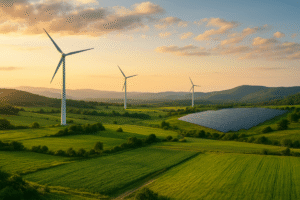Climate change is causing significant human, economic and environmental impacts in Europe, the continent that is warming faster than any other. During the year 2022, conditions of extreme heat, droughts and wildfires occurred.
Sea surface temperatures across Europe have reached new records, accompanied by marine heat waves. In addition, the melting of glaciers was unprecedented.
These are just some of the key data included in the 2022 European State of the Climate report. This report, the second in an annual series, was produced in collaboration between the World Meteorological Organization (WMO) and the Copernicus Climate Change Service (C3S).
Table of Contents
The European State of the Climate 2022 report
The paper shows how Europe is warming at twice the rate of the global average. Thus with significant impacts on the region’s socioeconomic fabric and ecosystems.
In 2022, Europe was about 2.3°C above the pre-industrial average, defined as the period between 1850 and 1900, which is the reference point in the Paris Agreement on climate change.
But there is a hopeful sign for the future. For the first time last year, renewable energy generated more electricity than polluting fossil gases. In 2022, wind and solar energy contributed 22.3 percent of the electricity generated in the European Union (EU), surpassing fossil gas use (20 percent).
The push for renewables
WMO Secretary General Prof. Petteri Taalas said that in the EU, for the first time, more electricity was produced from wind and solar energy than from fossil gas.
Increasing the use of low-carbon renewable energy sources is essential to decrease dependence on fossil fuels.
In addition, the professor emphasized the important role climate services play in promoting resilience of energy systems in the face of climate impacts, planning operations and informing measures to improve energy efficiency.
Record temperatures, droughts and glacier loss in 2022
Europe faced its hottest summer on record, with several countries experiencing the hottest year on record. Average annual temperatures were among the second- to fourth-highest, with an anomaly of about 0.79 °C compared to the 1991-2020 average.
Precipitation was below average, with prolonged drought in several regions, such as the Iberian Peninsula and the Alps. The effects of extreme heat have extended to agriculture and energy production. European glaciers suffered significant mass loss, particularly in the Alps.
The Greenland ice sheet continued to lose mass, contributing to sea level rise. Sea temperatures in the North Atlantic have been the warmest on record. With consequences such as marine heat waves, species migrations and ecosystem alterations.
In addition, ocean surface temperatures in some regions have been much higher than the global average, with significant impacts on marine biodiversity and ecosystems.
Read also: Oceans turn green due to climate change: what are the dangers












